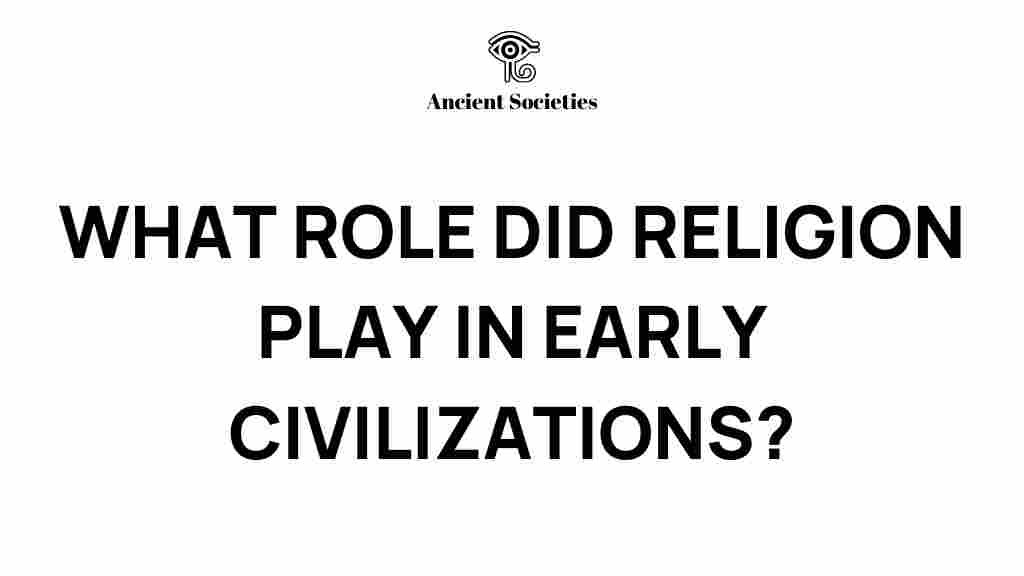Unveiling the Sacred: The Pivotal Role of Religion in Early Civilizations
Religion has been a cornerstone of human culture since the dawn of early civilizations. It shaped societies, influenced cultures, and provided frameworks for belief systems that guided the lives of countless individuals. In this article, we will explore the multifaceted role of religion in ancient societies, examining its impact on culture, rituals, and social structures, and how archaeology has unveiled the spiritual practices of our ancestors.
The Foundation of Religion in Early Civilizations
In the context of early civilizations, religion served as a unifying force that brought people together under shared beliefs and practices. The sacred rituals, mythologies, and deities defined the social fabric of these societies, influencing everything from governance to daily life.
The Origins of Belief Systems
The early belief systems were often polytheistic, worshipping multiple gods and goddesses who represented natural forces and aspects of life. This polytheism can be seen in:
- Mesopotamia: The Sumerians, Akkadians, Babylonians, and Assyrians worshipped a pantheon of gods associated with natural phenomena.
- Ancient Egypt: The Egyptians revered gods like Ra, Osiris, and Isis, whose stories explained the cycles of nature and life after death.
- The Indus Valley Civilization: Evidence suggests that this civilization had complex religious practices, possibly involving fertility cults and mother goddess worship.
- Ancient China: Early Chinese religions included ancestor worship and the veneration of nature spirits.
Spiritual Practices and Rituals
The spiritual practices of these early societies were diverse and deeply integrated into the daily lives of individuals. Rituals were performed to appease the gods, seek favor, or ensure good fortune. Common practices included:
- Ritual Sacrifices: Animals or crops were often sacrificed to deities to gain their favor.
- Festivals: Seasonal festivals celebrated agricultural cycles, honoring deities associated with fertility and harvest.
- Burial Practices: Elaborate burial rites reflected beliefs about the afterlife, as seen in the pyramids of Egypt or the tombs of Mesopotamian kings.
The Social Impact of Religion
Religion did not exist in a vacuum; it was intertwined with the political and social structures of early civilizations. The authority of leaders often derived from religious legitimacy, and this interplay shaped society in profound ways.
Religion and Governance
In many ancient societies, rulers were seen as divinely appointed or even as gods themselves. This divine right to rule created a connection between religion and governance:
- Pharaohs of Egypt: Considered both political leaders and divine beings, pharaohs were central to the religious life of Egypt.
- Mesopotamian Kings: Kings like Hammurabi claimed to be chosen by the gods, which helped legitimize their authority.
- The Mandate of Heaven in China: This concept linked the emperor’s right to rule with the approval of the divine, reinforcing the importance of moral governance.
Community and Identity
Religion also played a crucial role in forming community identities. Shared beliefs and rituals fostered a sense of belonging and solidarity among individuals:
- Shared Myths: Myths and legends created common narratives that unified communities.
- Religious Institutions: Temples and shrines served as centers of community life, where people gathered for worship and social activities.
- Religious Leaders: Priests and shamans held significant influence, guiding spiritual practices and community decisions.
Archaeological Insights into Ancient Religions
The study of archaeology has provided invaluable insights into the religious practices of early civilizations. Excavations of ancient sites have uncovered artifacts, temples, and burial sites that reveal the spiritual lives of our ancestors.
Artifacts and Religious Symbols
Archaeological discoveries often include religious artifacts that shed light on the belief systems of ancient societies:
- Statues and Idols: Many ancient cultures created statues of their deities, reflecting their importance in daily worship.
- Offerings and Altars: Sites often contain altars or areas designated for sacrifices and offerings, indicating the ritual practices of the time.
- Religious Texts: Cuneiform tablets from Mesopotamia and hieroglyphs from Egypt provide written records of religious beliefs and practices.
Ritual Sites and Temples
Excavated temples and ritual sites offer a glimpse into the architectural grandeur and significance of religious practices:
- Ziggurats: These massive structures in Mesopotamia served as temples and were believed to connect heaven and earth.
- Pyramids: Egyptian pyramids were not only tombs but also monumental expressions of their beliefs in the afterlife.
- Stone Circles and Monoliths: Sites like Stonehenge suggest early forms of religious gatherings and astronomical alignments.
Challenges in Understanding Ancient Religions
Despite the wealth of archaeological evidence, understanding the full scope of religious beliefs in early civilizations remains challenging. Here are some hurdles researchers face:
- Interpretive Bias: Modern interpretations of ancient practices can be influenced by contemporary beliefs and biases.
- Incomplete Records: Many ancient texts and artifacts have been lost or damaged, leading to gaps in our understanding.
- Cultural Context: Understanding the cultural nuances and specific contexts of ancient religions can be complex.
Conclusion
The role of religion in early civilizations was both profound and multifaceted. It shaped cultures, influenced societal structures, and provided frameworks for belief systems that guided human behavior. The archaeological discoveries continue to unveil the richness of spiritual practices in ancient societies, offering us glimpses into their lives.
As we explore the past, we gain a deeper understanding of how religion has historically influenced societies and how these ancient beliefs continue to resonate in our modern world. By studying the sacred traditions of early civilizations, we not only honor their legacy but also enrich our own cultural identities.
For more insights into ancient cultures, visit this resource. To delve deeper into the role of archaeology in uncovering these historical influences, check out this informative article.
This article is in the category History and created by AncientSocieties Team

1 thought on “Unveiling the Sacred: The Pivotal Role of Religion in Early Civilizations”